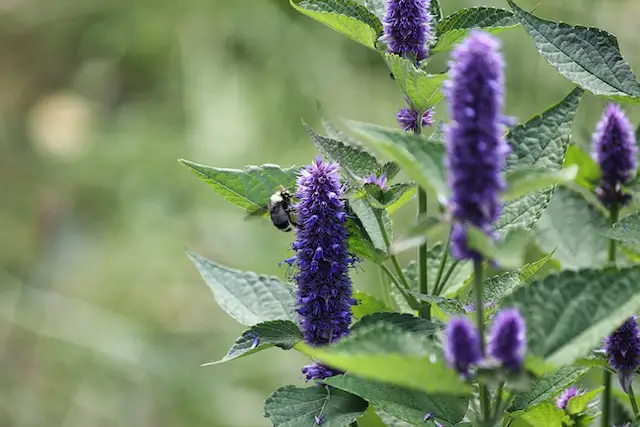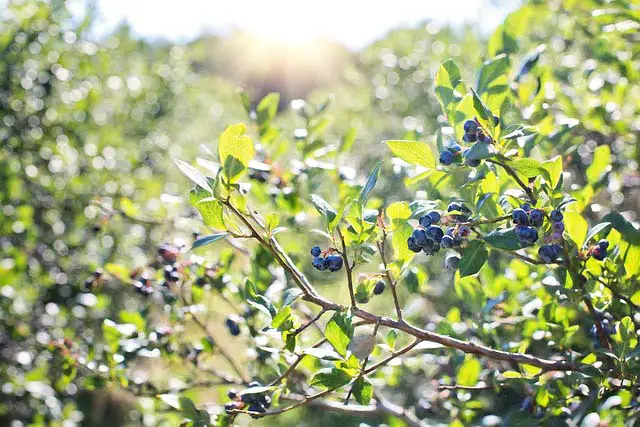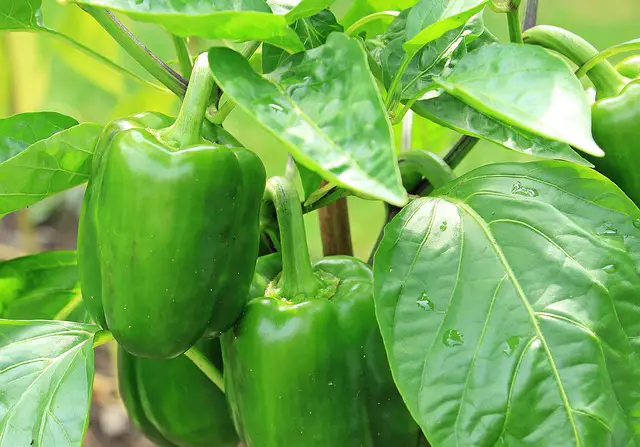
I’m quite proud of my little blackberry patch, tucked into an underutilized green area on the side of my house near the driveway. It is, however, fairly utilitarian-looking at the moment and does not add much to my home’s curb appeal. I’d love to incorporate the blackberries into my landscape better – and perhaps provide some benefits to the plants as well.
So, it’s time for some companion plants. I often find lists of companions overwhelming…I mean, how do you choose what to plant from such a long list? Which plants will provide the most benefit for my blackberries, and how do I decide which ones I need? And, perhaps even more important, are there any plants I should avoid?
The best companion plants for blackberries are those that repel pests, attract beneficial insects, and thrive in similar conditions. Tansy, borage, alliums, and herbs are helpful blackberry companions. Avoid raspberries, wild blackberries, nightshades, and heavy-feeding plants near blackberries.
Adding companion plants is a simple way to not only make your blackberry patch more beautiful, but to benefit the bushes in a number of ways. Before getting to the list of the most helpful blackberry companions, let’s first dive into how to choose which plants you need.
Choosing What to Plant with Blackberries
What do blackberries need from companions?
Blackberries naturally grow in a variety of habitats, including woodlands, dry prairies, roadsides, on the banks of streams, and just about everywhere in between. So when it comes to companions, the choices are pretty broad. In reality, blackberries will grow well with just about anything (with a few exceptions, which you’ll see at the end of this post).

But there are some ways that specific companions can be helpful to blackberries. For example, certain plants can be grown as living mulch – low to the ground and thick enough to shield the blackberry bush’s roots from the hot sun and conserve moisture in the soil.
Other plants help to enhance the soil’s health and make more nutrition available to the blackberry plant. Decaying plant matter decomposes into the soil and feeds the microorganisms, which in turn make nutrients that the roots can absorb.
Some plants grow in such a way that they convert available nutrients, such as nitrogen, to a different form that is absorbable by the blackberry bush. Certain companions’ roots grow deep, aerating the soil, which allows for better root growth.
Some companion plants can naturally repel pests, or attract predatory insects that will feed on bugs that could harm the blackberry plant. Companions may also attract more pollinators to the area, thereby increasing the potential fruit harvest.
Related: 6 Ways to Grow Bigger, Juicier Blackberries
Blackberry companions can even do something as simple as providing shade from the extreme afternoon heat. Blackberries do need full sun in order for the fruit to ripen to its full sweetness, but some protection from strong afternoon sun can prevent sun scald and other issues.
What might affect your choice of companion plants?
Consider your space and the location of the blackberry bush. Are your blackberries in long, neat rows? Are you growing just one sprawling bush in the middle of your garden? Do you have limited space, or a whole area that you could fill with other plants?

The answers to these questions can help you determine how much room you have for companion planting, and how best to utilize that space. Perhaps the best choice would be a few scattered containers that incorporate some of the helpful companions listed below. Or maybe alternating different plants in between blackberry rows is the right choice.
To learn how to relocate an established blackberry shrub, visit Transplanting a Mature Blackberry Bush: Tips to Do It Right.
If you live in a hot, humid climate, you may want to provide some taller companion plants or trees to partially shade the blackberries in summer afternoons. If your soil is sandy and lean, then plants that provide some cover for the soil surface will help retain moisture and feed the soil as they break down.
Assess your site, soil, climate, and specific nutrient needs. Use those categories to narrow down which plants will work best for your situation.
What are you trying to accomplish in your garden?
As I said at the top of the article, my blackberries are on the side of my house near my driveway. Since the area is visible to the street, I want it to look neat and inviting. Of course, blackberry brambles are hardly a “neat” plant, with their long arching canes and spreading habit. So I plan to add some order to the situation using strategically placed potted companion plants.

If your plants are in long, neat rows, then try alternating them with rows of beneficial companions.
If your blackberry bushes are more integrated into your garden, then consider what other colors, forms, or sizes of plants would look best. Do you need some plants that are low to the ground? Or something tall that can line the fence behind the blackberry bush?
For a charming, cottage-garden look, incorporate plenty of old-fashioned flowers and herbs into the area.
Perhaps your goal is to grow your own food forest and have as many edible plants as possible. Consider adding plants that do double duty, such as strawberries as groundcover, or herbs that both repel pests and can be used in the kitchen.
The Most Helpful Companion Plants for Blackberries
These useful plants provide the most potential benefits for blackberry bushes. Many of these plants make great companions for just about everything in your garden. You can’t go wrong by incorporating a few around your blackberry patch.
1. Tansy
Tansy is an easy-to-grow wildflower (and sometimes weed) that has a lot of benefits for blackberries. It has a strong scent that naturally repels many problematic pests, such as cucumber beetles, squash bugs, Japanese beetles, aphids, and even ants.

It grows to be about 4 feet tall and is covered in long-blooming, small, tight-petaled, yellow flowers. The flowers attract honeybees and other pollinators, as well as pest predators like ladybugs (who love to lay their eggs on tansy).
Tansy even benefits the soil it grows in. Not only will in thrive in even the leanest soils, it accumulates potassium as it grows, and converts available nitrogen to a form that can be absorbed by other plants.
Its adaptable nature can be a problem, though. Tansy reseeds easily and also spreads by rhizomes underground. In some parts of North America, it’s considered an invasive species and is prohibited. Be careful around pets, kids, and livestock as well – the natural oils that make it a great pest repellant are toxic when ingested.
2. Hyssop
Hyssop is an evergreen herb in the mint family. It grows to be about 18 to 24 inches tall and wide, and prefers a sunny, well-drained location. It has traditional culinary and medicinal uses, but it also makes a great companion plant for blackberries and other fruits.

The long, lavender flowers of hyssop are exceptionally good at attracting pollinators and other beneficial insects. The strong minty smell will also deter certain pests, such as aphids, Japanese beetles, and whiteflies. As a bonus, it can also be a “trap crop” for cabbage moths to lay their eggs on, hopefully leaving your nearby brassicas alone.
Hyssop is drought-tolerant and easy to grow. It does, however, prefer nearly neutral to slightly alkaline soil (pH of 6.7-8.5). Since blackberries grow best in slightly acidic soil, place hyssop in pots nearby to keep both plants happy.
3. Blueberries
The big reason to plant blueberries near blackberries is that they both thrive in similar growing conditions: Full sun and well-drained, acidic soil. But did you know that growing blueberries nearby can actually help increase blackberry yields (and vice versa)?

Blueberries bloom for a long time and are great at attracting pollinators that will also pollinate blackberries. They can also attract other beneficial insects that will keep pests under control.
The best part about using blueberries as companions is that they’re not only benefitting the blackberries, they’re also providing you with another edible crop.
4. Strawberries
Strawberries work well as groundcover underneath blackberries. They spread relatively quickly, and the dense leafy growth will shade the ground and keep excess water from evaporating. Strawberries need full sun in order to ripen, but they will tolerate some shade from the blackberry plants.

Strawberries are best as a companion to early-blooming blackberries. The little white blossoms will attract pollinators to the blackberry bush, as long as the blackberry is also flowering.
Make sure there is plenty of air circulation underneath the blackberry bush in order to prevent disease from spreading between the plants. Strawberries have relatively shallow roots, so they won’t compete for nutrients with the blackberries.
To prevent the fruit from rotting, spread some straw or pine needles around the strawberry plants. Growing garlic or chives nearby will help keep away unwanted pests.
5. Peas or Beans
Legumes are good companion plants to many fruit crops, largely because they fix nitrogen in the soil. Nitrogen is an element that’s essential for blackberry growth.
Learn more: Blackberry Fertilizing: What to Use to Grow the Best Berries

For the most benefit to the soil, grow beans or peas densely as a cover crop in the fall, then mow them down so that they break down into the soil over the winter. Or, you can grow them along a fence or with other supports behind a row of blackberry bushes.
You can also grow compact varieties of peas, such as ‘Sugar Flash’, or bush beans, such as ‘Desperado’, if space is an issue.
6. Borage (Starflower)
Borage, also called Starflower, is an annual herb with beautiful clusters of bright blue-purple flowers. It is a big attraction for honey bees, native bees, bumblebees, and other pollinators.

Borage attracts beneficial insects that are predators of many pests, such as braconid wasps and hoverflies. Its smell also helps repel caterpillars, including cabbage worms and tomato hornworms.
This is a great plant to place near blackberries, as its deep tap root will bring up trace minerals and make them available to other plants. Many people grow borage just to have the plants to compost at the end of the season. Even as the herb dies and decomposes, it releases calcium and potassium into the soil.
7. Chives, Garlic, and Other Alliums
Garlic is famously used as a companion to roses, as it helps keep aphids away. Since blackberries are in the same plant family as roses (Rosaceae), it stands to reason that garlic and its other allium cousins will be great companions for blackberries.
Plants in the Allium genus are some of the best pest repellers you can get. Garlic, chives, onions, and other strongly-scented alliums repel a long list of pests, including beetles, slugs, aphids, cabbage worms, borers, and spider mites.

Garlic also has some antifungal properties that may benefit nearby plants. All alliums tend to have shallow roots that won’t compete with the blackberry bush’s root system.
Tuck in some chives between plants or along the front of a row of blackberries. The ornamental purple, lavender, or white flowers look beautiful next to just about any plant, and they also attract tons of pollinators.
8. Herbs
Just about any herb works well planted near blackberries. As long as they tolerate the full sun and acidic soil that blackberries need, they’ll grow happily. A few of the other companion plants on this list are herbs as well (borage and hyssop, for example), but there are even more options.
Strong-scented herbs such as thyme, oregano, basil, or rosemary will help keep pests away, and their shallow roots won’t compete with the blackberries. Parsley, like garlic, has antifungal properties and can help prevent fungal disease.

Mint (and other flowering herbs) will encourage pollinators to come by. Its strong menthol scent deters pests, including aphids, ants, and even mice. If you have the space, let mint spread as a mulch, then allow it to break down and add nutrients to the soil.
Proceed with caution, though – mint can spread aggressively. Unless you have tons of room (or you really love mint), keep it in a pot to be on the safe side.
Here’s a list of herbs to try near blackberries:
- mint
- basil
- thyme
- oregano
- rosemary
- chives
- basil
- lemon balm
- parsley
- cilantro/coriander
- chamomile
- rue
9. Nasturtiums
It’s hard to think of a plant that’s more useful, easy to grow, and beautiful than nasturtiums. These annual trailing flowers come in just about every shade of orange, red, pink, peach, cream, lavender, purple, yellow, gold, and burgundy. They adapt to almost every soil type, although they prefer a similar pH level to blackberries (6.5).

Nasturtiums are edible, long-flowering, and ornamental. They can be grown in containers or left to spread as a groundcover. Their blooms attract pollinators, and at the same time their peppery scent repels pests like borers and beetles. Aphids and and other pests will flock to the nasturtiums instead of to other crops.
Nasturtiums are not heavy feeders. Even if grown as a groundcover underneath blackberries, they won’t compete for nutrients.
10. Bee Balm (Bergamot)
Bee balm is a beautiful perennial with firework-shaped red, pink, or white flowers. It’s a magnet for beneficial insects and hummingbirds, but also repellent to deer.

It has scented foliage that deters many kinds of harmful insects. Even the roots bee balm contain fragrant oils that may help prevent below-the-ground pest problems.
Most bee balms spread easily (sometimes aggressively) and reach 2 to 4 feet tall. There are some compact, less aggressive varieties such as ‘Petite Delight’ that will stay under 2 feet tall and wide. Try planting bee balm in a nearby border, not too close to the blackberries, to avoid competition.
Other Good Blackberry Companions to Try
This next group of companions may have some benefits for blackberries, but in a more indirect or general way. Consider mixing in a couple of these:
Radishes
Radishes can work as a quick-growing, shallow groundcover near blackberry bushes. They will appreciate the partial shade under the blackberries’ leafy growth. Think of this as a space-saving option – you have some room around your blackberry plants, so why not grow an edible crop while also shading the soil?
Leafy Greens
Greens such as lettuce, kale, or mustard will work similarly to radishes. They serve as living mulch around a blackberry bush and will grow well in the shade of the bramble. Mustard greens, in particular have some antifungal properties and may help prevent fungal disease from taking hold.
Sunflowers
A tall border of sunflowers could possibly keep the deer away from blackberry bushes – as in, the deer are so busy munching on the sunflowers, they may not notice the berries (one can hope, right?). Even if this ideal scenario doesn’t quite hold up, sunflowers do attract a lot of pollinators. They also won’t compete with blackberries for the same nutrients.

Mulberry Trees
The main reason for growing a mulberry tree near blackberries is the fact that mulberries have such a long bloom time. Longer blooming means more pollen and nectar for the pollinators to collect and spread, leading to more fruiting all around. A mulberry tree needs a lot of space, however, so best not to plant it too close.
Grapes
In this case, it’s blackberries that are more of a companion for grapes. This is because blackberries play host to a particular parasite that kills a big threat to grapes – grape leaf hoppers. Blackberry roots also loosen the ground for the grapes’ roots to spread.
Oak Trees
I didn’t think it fair to list oak trees as a primary companion plant to blackberries, simply because they’re so big. How can a giant tree be a companion plant?
In this case, the sprawling canopy of an oak can provide dappled shade during the heat of summer. Leaves that drop will break down over time, enriching the soil. There are even mycorrhizal fungi in the roots of oak trees, which is known to help nutrient absorption and can prevent certain diseases.
What NOT to Plant Near Blackberries
Blackberries may be friendly to most other plants, but there are some things that should not be located close by. Avoid these problematic plants near blackberries:
Nightshade Plants

Plants in the nightshade family include tomatoes, peppers, eggplants, tomatillos, and white potatoes. These are notoriously susceptible to diseases, which means they can easily spread problems to blackberries and other crops.
Carrots (and Other Deep-Rooted Crops)
Avoid planting carrots and other deep-rooted vegetables (parsnips, beets, turnips) too close to blackberry plants. They may crowd out the roots of a blackberry and compete for nutrition if located nearby.
Asparagus (and Other Heavy Feeders)
Asparagus is one of the heaviest-feeding plants, and its roots grow very deep. It may deplete the nearby soil of too many nutrients that the blackberry plant also needs.
Wild Blackberries
The invasive, thorny, wild blackberry cousin to cultivated blackberries may be delicious, but it can also be problematic. Wild blackberries are host to many diseases that can infect and ruin your blackberry patch. If you have both, keep them as far apart as possible.
Raspberries
Raspberries and blackberries are both brambles in the Rubus genus. This means they share many of the same characteristics – and they are also susceptible to many of the same diseases. Planting raspberries and blackberries too close together can increase the likelihood and severity of soil-borne diseases for both plants. Try to keep blackberries and raspberries at least 50 feet apart.

